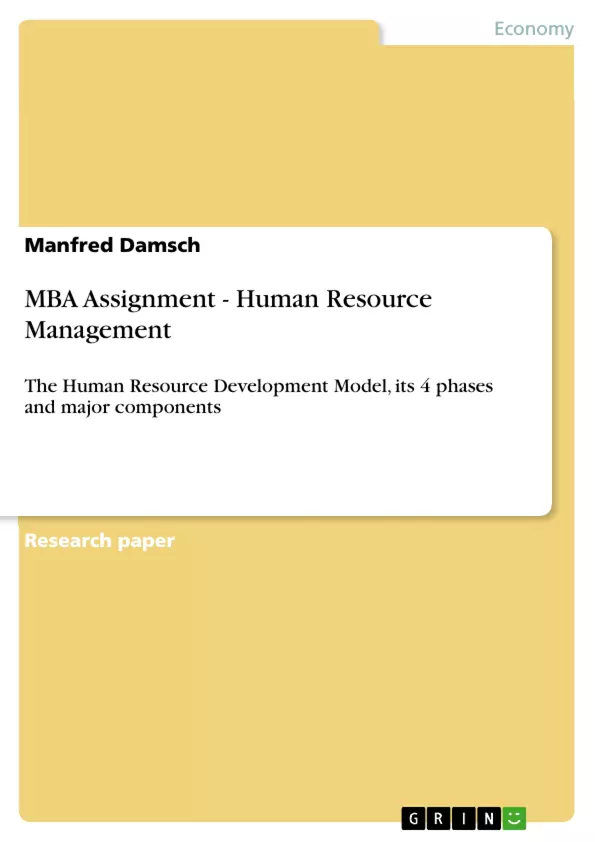Responsibilities within Human Resource Management are many-layered and complex not at least because of interdependencies from the company’s goals, visions and strategy. This means that there is a very close relationship between the management and HR. Beside this, HR also stands for the human needs and has to find the balance between those two indeed divisive views, always with the target ahead to make the company most efficient.
For being most efficient by transferring and enabling the staff to fulfil the company’s targets it is helpful to set up and run along a model, which is aligned with the management and transparent to the organisation.
The Human Resource Development (HRD) model helps align management’s operational goals with employee concerns. Transparent to the organisation, this model supports processes for meeting operational targets while simultaneously empowering the staff.
Inhaltsverzeichnis (Table of Contents)
- Executive Summary
- Table of Contents
- List of Abbreviations
- List of Figures
- 1 Introduction
- 2 Problem Definition
- 3 Objectives
- 4 Methodology
- 5 The four Phases of HRD
- 5.1 Needs Analysis
- 5.2 Design
- 5.3 Delivery
- 5.4 Evaluation
- 5.5 The complex interaction of HRD
- 7 The Siemens HRD System (EFA)
- 8 Conclusion
- Bibliography
- Further Sources
- Appendix 1: ITM Checklist
Zielsetzung und Themenschwerpunkte (Objectives and Key Themes)
This paper aims to describe and standardize a system for guiding staff through the process of change over time. It focuses on the practical definition and application of Human Resource Development (HRD) within organizations, particularly in the context of significant strategic changes. The paper highlights the four key phases of HRD, emphasizing their interconnectivity and impact on the organization's effectiveness.- The importance of aligning HRD with organizational goals and strategy.
- The four phases of HRD: Needs Analysis, Design, Delivery, and Evaluation.
- The complex interplay of HRD processes and their influence on organizational performance.
- The role of HRD in managing organizational change, particularly restructuring and downsizing.
- The significance of HRD in developing employee skills and capabilities to ensure long-term organizational success.
Zusammenfassung der Kapitel (Chapter Summaries)
- Introduction: The chapter introduces the concept of HRD and its role in maintaining employee qualifications, preparing them for future challenges, and ensuring organizational competitiveness. It emphasizes the relationship between HRD and team development as well as organizational development, ultimately aligning with the company's vision and targets. The chapter also addresses the debate surrounding the purpose of HRD, exploring perspectives on its focus on economic and social benefits versus training, development, and learning within organizations.
- Problem Definition: This chapter highlights the constant nature of change and its impact on employees and organizations. It emphasizes the necessity for employees to adapt to changing work styles, behaviors, and expectations. The responsibility of Human Resources and management to efficiently and effectively support and manage this change is emphasized.
- Objectives: This chapter outlines the primary objective of HRD: to describe and standardize a system that guides staff through the process of change over time. This system aims to provide structure and clarity for navigating the dynamic landscape of organizational evolution.
Schlüsselwörter (Keywords)
The primary focus of this paper is on Human Resource Development (HRD), its four phases (Needs Analysis, Design, Delivery, and Evaluation), and its role in managing organizational change, particularly in the context of strategic changes like restructuring and downsizing. Other key concepts include employee development, organizational goals, staff skills, and competency-based training. The paper also explores the interaction of HRD with team development, organizational development, and the company's vision and targets.- Arbeit zitieren
- Manfred Damsch (Autor:in), 2008, MBA Assignment - Human Resource Management, München, GRIN Verlag, https://www.grin.com/document/134441



